Intel Bundle
How has the Intel Company Shaped the Tech World?
From humble beginnings to global dominance, the Intel SWOT Analysis reveals a story of relentless innovation. Founded in 1968, Intel, a cornerstone of the technology revolution, has continuously redefined the boundaries of computing. This is the saga of Intel's journey, from its early processors to its current position in the semiconductor market.
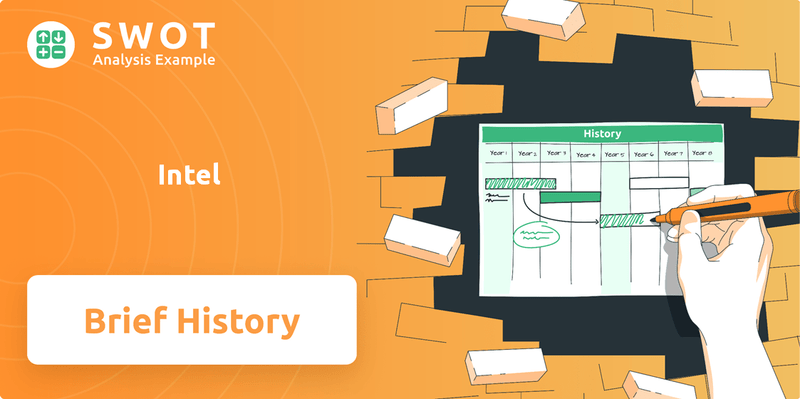
This brief history of Intel delves into the key milestones that have defined the Intel corporation. Explore the Intel founders' vision and the evolution of Intel processors, from the first microprocessor to the advanced chips powering today's devices. Understanding Intel's history provides critical context for its future in a rapidly changing technological landscape, highlighting its enduring impact on Silicon Valley and beyond.
What is the Intel Founding Story?
The story of the Intel company begins with a bold move by two semiconductor pioneers. Robert Noyce and Gordon Moore left Fairchild Semiconductor to create a new venture, aiming to revolutionize the tech industry. Their vision and expertise set the stage for what would become a global technology leader.
Intel was founded on July 18, 1968. The company's early focus was on innovation, aiming to develop advanced data storage devices. The founders' deep understanding of semiconductor technology was key to their initial success and laid the foundation for their future in the rapidly evolving electronics industry.
The company's initial operations started in a conference room in Mountain View, California. With a small team of engineers, Intel began its journey. Their commitment to research and development was crucial in the early years, setting them apart from competitors and driving their growth.
Intel Corporation was born out of the vision of Robert Noyce and Gordon Moore. Their departure from Fairchild Semiconductor marked the beginning of a new era in the semiconductor industry. Arthur Rock, an investor, played a crucial role in securing initial funding.
- Intel founders, Robert Noyce and Gordon Moore, were key figures in the integrated circuit revolution.
- The original business model focused on advanced data storage devices, specifically computer memory chips.
- The company was initially named 'NM Electronics,' but was soon rebranded to 'Intel.'
- Early Intel operations began on August 1, 1968, with a small team of engineers.
The founders, Noyce, a physicist, and Moore, a chemist, brought unique expertise to the table. Noyce co-invented the integrated circuit, while Moore formulated Moore's Law. This law would become a guiding principle for the company's technological advancements. The company's initial name, 'NM Electronics,' reflected their surnames. However, they later chose 'Intel,' a portmanteau of 'Integrated Electronics'.
Intel's initial focus on research and development was crucial. This early emphasis on innovation allowed Intel to create technologies that were not available elsewhere. This strategy helped establish Intel as a leader in the rapidly changing electronics industry. To learn more about Intel's business model, you can read about the Revenue Streams & Business Model of Intel.
Intel SWOT Analysis
- Complete SWOT Breakdown
- Fully Customizable
- Editable in Excel & Word
- Professional Formatting
- Investor-Ready Format
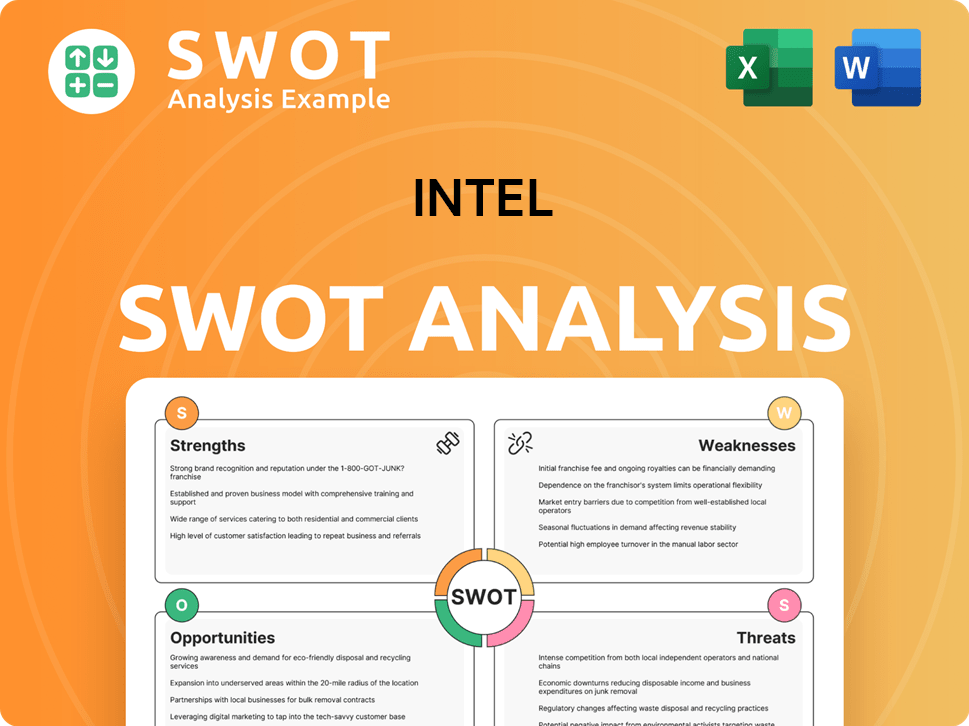
What Drove the Early Growth of Intel?
The early growth of the Intel company was marked by significant technological advancements and strategic product introductions. The Intel history includes early success with SRAM and DRAM memory chips. A pivotal moment arrived with the creation of the 4004 microprocessor in 1971. Although the industry adoption was initially slow, this was a significant innovation.
Initially, Intel found success with SRAM and DRAM memory chips. These components were crucial in the early days of computing. This early focus laid the groundwork for their future advancements in processors.
The 4004 microprocessor, created in 1971, was a significant innovation. It was a tiny chip with more memory than the first electronic computer ENIAC. This chip was a foundational step for future processor development.
In 1981, IBM selected Intel's 8088 processor for its personal computers. This decision significantly boosted Intel's standing in the growing PC market. This partnership was a turning point.
The introduction of the 80286 processor in 1982 further solidified Intel's position. The x86 CPU architecture became a standard for decades. This established Intel as a dominant player.
The company's revenue surged from $3,000 to $66 million within five years of its founding, demonstrating rapid market penetration. Intel expanded its operations, establishing its largest operating site in Oregon. By 2008, Intel was Oregon's top private employer, with a workforce of approximately 15,500. For more information about the Intel's target market, check out the Target Market of Intel.
The company expanded its manufacturing footprint. Plans include shifting high-volume production of 3nm chips to its Fab 34 facility in Ireland later in 2025. The company received nearly $8 billion in direct funding under the U.S. CHIPS and Science Act.
Intel has faced increasing competition from AMD. This intense competitive landscape, coupled with a stagnating PC industry, contributed to Intel's CPU market share dropping to around 60% by 2024, down from 80% in 2015.
In response to market challenges, Intel has undertaken strategic shifts. A major cost-reduction plan aims to save $10 billion by 2025. The company is also focusing on its integrated device manufacturing (IDM) model.
In November 2024, Intel received $1.5 billion for its Ohio One project. The company's financial strategies are evolving to adapt to the competitive landscape. These moves are designed to ensure long-term success.
Intel PESTLE Analysis
- Covers All 6 PESTLE Categories
- No Research Needed – Save Hours of Work
- Built by Experts, Trusted by Consultants
- Instant Download, Ready to Use
- 100% Editable, Fully Customizable
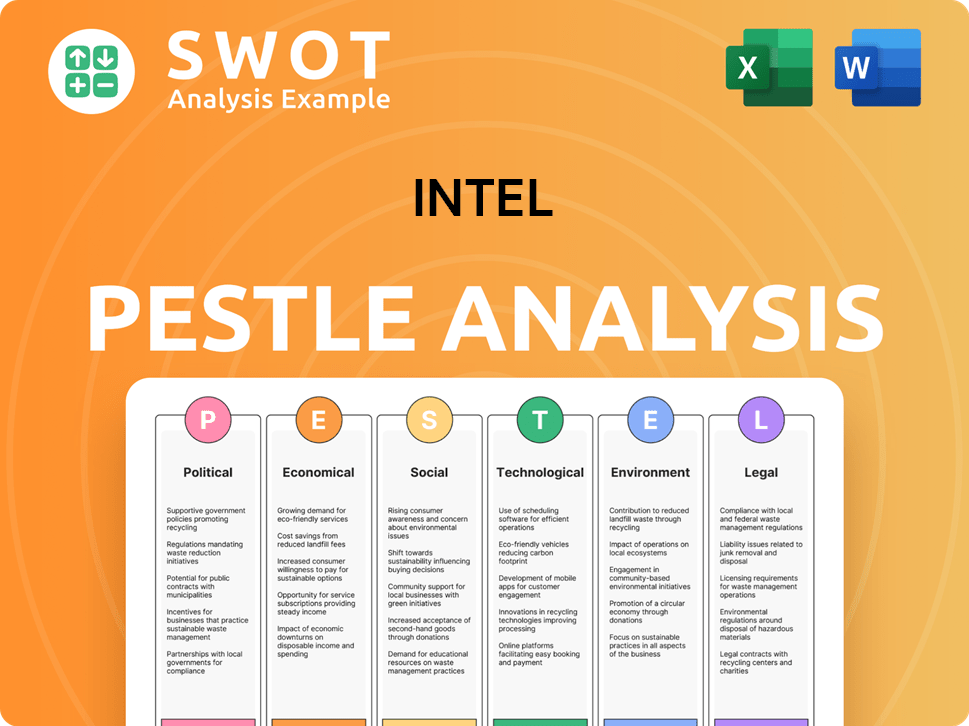
What are the key Milestones in Intel history?
The Intel company, a titan in the tech industry, has a rich history marked by significant milestones. From its humble beginnings to its current standing, Intel's journey is a testament to innovation and resilience. The Intel corporation has consistently pushed the boundaries of what's possible in computing, leaving an indelible mark on the world.
| Year | Milestone |
|---|---|
| 1968 | Intel was founded by Intel founders Robert Noyce and Gordon Moore. |
| 1971 | Intel introduced the 4004, the first commercial microprocessor, revolutionizing computing. |
| 1981 | Intel's 8088 processor was adopted by IBM for its personal computers, solidifying Intel's dominance. |
| 1980s | The x86 CPU architecture became an industry standard, powering countless applications. |
| 2007 | Intel made a strategic misstep by declining to supply chips for Apple's iPhone, allowing ARM-based chips to gain dominance in mobile. |
| 2024 | Intel's stock declined by over 50%, and the company was removed from the Dow Jones Industrial Average. |
| 2025 | Lip-Bu Tan was appointed CEO in March, signaling a strategic reset for the company. |
Intel has been at the forefront of technological advancements, particularly in the realm of microprocessors. Its innovations have driven the evolution of personal computing and data centers, shaping how we interact with technology. The company's commitment to research and development has consistently yielded groundbreaking products.
The 4004, Intel's first microprocessor, was a pivotal innovation, marking the beginning of the microcomputer revolution.
The x86 architecture became the standard for CPUs, powering the majority of PCs and servers for decades.
Intel consistently developed more powerful and efficient processors, driving improvements in computing performance.
Intel integrated graphics processing units (GPUs) into its processors, enhancing visual capabilities.
Intel's advancements in manufacturing processes have led to smaller, faster, and more energy-efficient chips.
Intel's IDM 2.0 strategy emphasizes in-house fabrication and expanding foundry services to regain manufacturing leadership.
Despite its successes, Intel has faced numerous challenges, including intense competition and strategic missteps. Manufacturing delays and shifts in market dynamics have tested the company's resilience. The company has also had to navigate significant financial and operational hurdles, as highlighted in the marketing strategy of Intel.
Intel's failure to capitalize on the mobile market allowed ARM-based chips to dominate this segment.
Delays in transitioning to advanced process nodes like 10nm and 7nm hindered Intel's competitiveness.
Competitors like AMD gained significant market share in both consumer and enterprise CPUs.
Intel experienced a net loss of $887 million in Q1 2025 on a GAAP basis, though non-GAAP results showed profitability of $580 million.
The company initiated a cost-reduction plan aiming to save $10 billion by 2025 through structural and operating realignment.
The abrupt retirement of former CEO Pat Gelsinger in December 2024 and the appointment of Lip-Bu Tan as CEO in March 2025 signaled a strategic reset.
Intel Business Model Canvas
- Complete 9-Block Business Model Canvas
- Effortlessly Communicate Your Business Strategy
- Investor-Ready BMC Format
- 100% Editable and Customizable
- Clear and Structured Layout
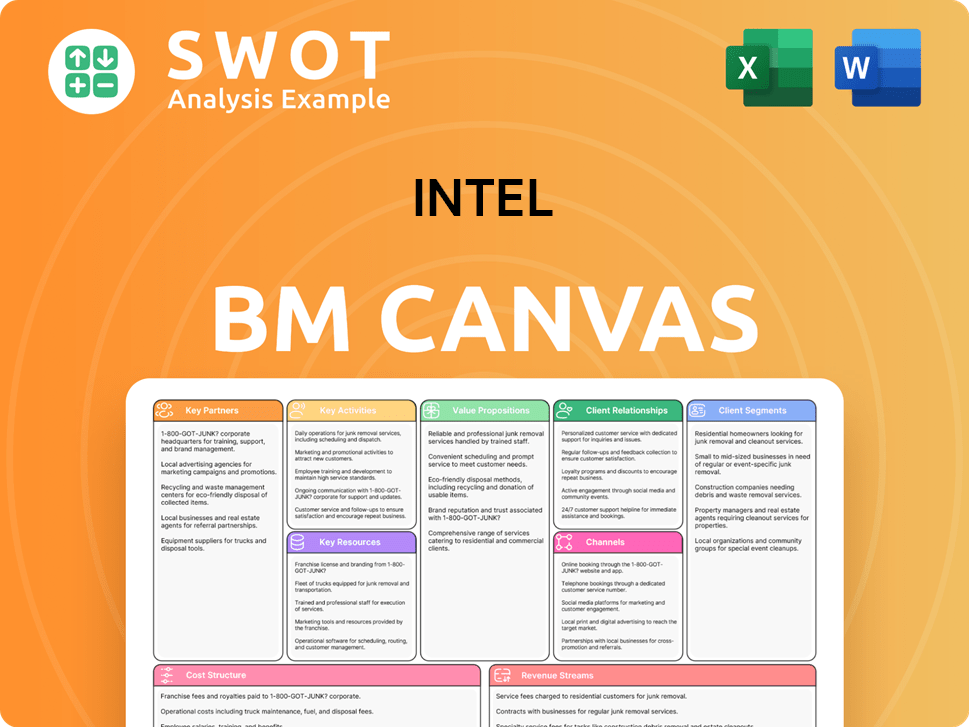
What is the Timeline of Key Events for Intel?
The Intel company has a rich Intel history, marked by significant technological advancements and strategic shifts. From its inception to its current focus on AI and advanced manufacturing, the company's journey reflects the evolution of the semiconductor industry. The Intel founders Robert Noyce and Gordon Moore set the stage for decades of innovation.
| Year | Key Event |
|---|---|
| July 18, 1968 | Founded as NM Electronics, later renamed Intel. |
| 1971 | Introduced the Intel 4004, the first commercial microprocessor. |
| 1981 | IBM selected Intel's 8088 processor for its personal computers, a major turning point. |
| 1982 | Debut of the 80286 processor, establishing the x86 CPU architecture. |
| 2007 | Then CEO Paul Otellini declined a deal to supply chips for Apple's iPhone, a missed opportunity. |
| 2015 | Held an 80% share in the client and server CPU market. |
| 2021-2024 | Experienced a significant revenue decline of over 30% due to increased competition and manufacturing delays. |
| November 2024 | Removed from the Dow Jones Industrial Average and replaced by Nvidia. |
| December 2024 | CEO Pat Gelsinger retired, signaling a company reset. |
| January 30, 2025 | Reported fourth-quarter and full-year 2024 financial results, with full-year revenue at $53.1 billion. |
| March 2025 | Lip-Bu Tan assumed the CEO role. |
| April 24, 2025 | Reported first-quarter 2025 financial results, with revenue of $12.7 billion. |
| Second Half 2025 | Intel 18A process expected to ramp for high-volume production, supporting the launch of Panther Lake SKUs. |
| 2025 | Aims to ship 100 million units of AI PCs. |
Intel is focused on regaining its leadership in the semiconductor industry through its IDM 2.0 strategy. This involves in-house manufacturing and expanding its foundry services to external customers. The 18A manufacturing process, set for high-volume production in the second half of 2025, is central to this strategy.
Intel is heavily investing in AI, aiming to ship 100 million AI PCs by the end of 2025. The company is collaborating with over 100 independent software vendors (ISVs) to develop more than 300 AI-accelerated features. Lunar Lake and upcoming Panther Lake CPUs are designed to offer superior AI performance.
Intel expects to reduce its operating expenses to approximately $17 billion in 2025 and $16 billion in 2026 as part of its cost-cutting efforts. These measures are aimed at improving financial performance and competitiveness in the market.
While facing challenges, Intel's long-term outlook remains positive, with a focus on driving innovation and expanding its foundry business. This aligns with its founding vision of continuous technological advancement. For more insights, you can read about the history of Intel.
Intel Porter's Five Forces Analysis
- Covers All 5 Competitive Forces in Detail
- Structured for Consultants, Students, and Founders
- 100% Editable in Microsoft Word & Excel
- Instant Digital Download – Use Immediately
- Compatible with Mac & PC – Fully Unlocked
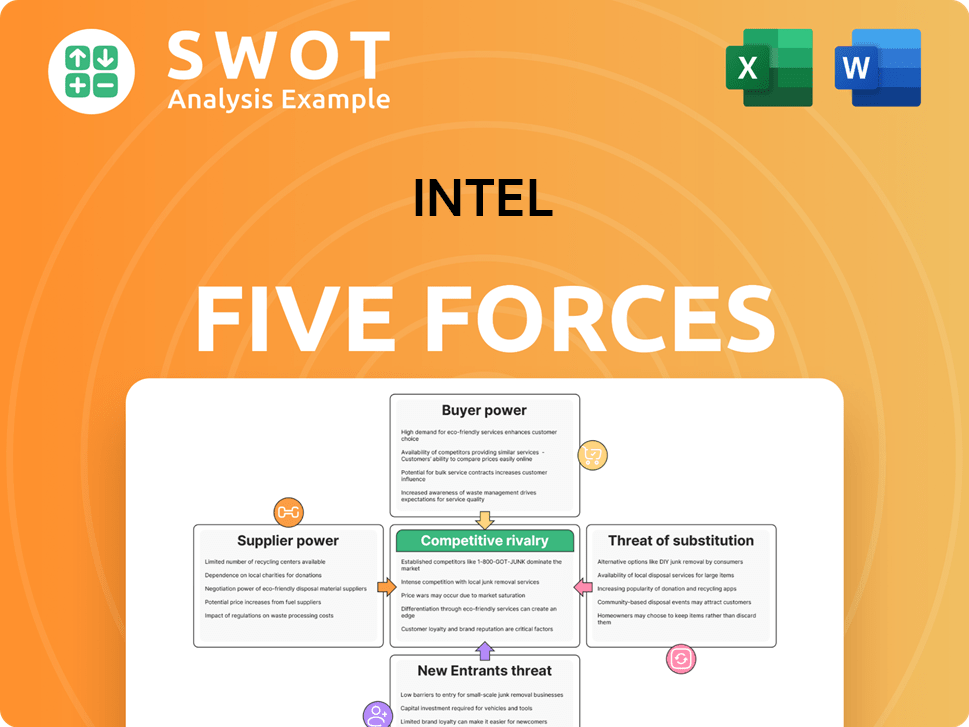
Related Blogs
- What is Competitive Landscape of Intel Company?
- What is Growth Strategy and Future Prospects of Intel Company?
- How Does Intel Company Work?
- What is Sales and Marketing Strategy of Intel Company?
- What is Brief History of Intel Company?
- Who Owns Intel Company?
- What is Customer Demographics and Target Market of Intel Company?
Disclaimer
All information, articles, and product details provided on this website are for general informational and educational purposes only. We do not claim any ownership over, nor do we intend to infringe upon, any trademarks, copyrights, logos, brand names, or other intellectual property mentioned or depicted on this site. Such intellectual property remains the property of its respective owners, and any references here are made solely for identification or informational purposes, without implying any affiliation, endorsement, or partnership.
We make no representations or warranties, express or implied, regarding the accuracy, completeness, or suitability of any content or products presented. Nothing on this website should be construed as legal, tax, investment, financial, medical, or other professional advice. In addition, no part of this site—including articles or product references—constitutes a solicitation, recommendation, endorsement, advertisement, or offer to buy or sell any securities, franchises, or other financial instruments, particularly in jurisdictions where such activity would be unlawful.
All content is of a general nature and may not address the specific circumstances of any individual or entity. It is not a substitute for professional advice or services. Any actions you take based on the information provided here are strictly at your own risk. You accept full responsibility for any decisions or outcomes arising from your use of this website and agree to release us from any liability in connection with your use of, or reliance upon, the content or products found herein.